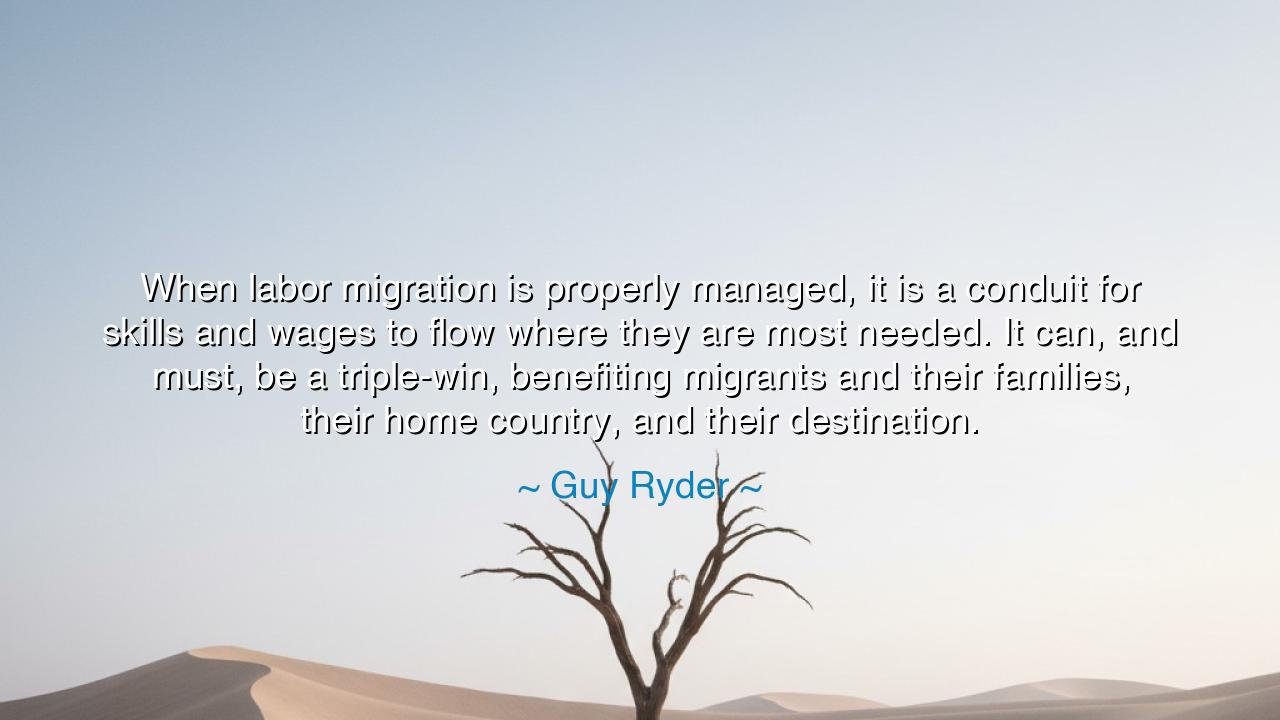
When labor migration is properly managed, it is a conduit for
When labor migration is properly managed, it is a conduit for skills and wages to flow where they are most needed. It can, and must, be a triple-win, benefiting migrants and their families, their home country, and their destination.






In the measured wisdom of Guy Ryder—“When labor migration is properly managed, it is a conduit for skills and wages to flow where they are most needed. It can, and must, be a triple-win, benefiting migrants and their families, their home country, and their destination.”—we hear the voice of a steward counting the grain of nations. This is not the rhetoric of walls or the fever of open gates; it is the craft of bridges. The sentence names a river that already runs beneath our feet: people moving with calloused hands and learned minds, carrying the power to mend shortages there and seed prosperity here, while sending lifeblood back to kin who wait with lamps in the window.
The ancients would have called this good order—nomos—set over the marketplace. For movement without measure can scatter a people, and restriction without reason can starve a city. Properly managed means covenant: rules that honor dignity, pathways that are clear, protections that hold when storms come. Then labor migration becomes what Ryder declares—a conduit, not a wound. Through it, skills cross deserts of scarcity, wages irrigate fields of hunger, and knowledge learned abroad returns like seasoned rain to the home country.
Consider a living parable. In the decades after war, Germany invited Gastarbeiter—“guest workers”—from Italy, then Turkey and beyond. Steel, rail, and factories needed hands; villages in Anatolia and the Mediterranean needed wages. When the compact worked, it was a triple-win: industry met its labor shortfall; migrants earned steady pay and sent remittances that built houses and schooling; families learned to dream in more than one language. Where management erred—housing cramped, credentials ignored, integration timid—the win thinned. The lesson endures: design matters. Fair contracts, language access, family stability, and pathways to belonging transmute mere labor into lasting commonwealth.
Or take the quiet heroism of nurses traveling from the Philippines to the United Kingdom and the United States. Where agreements respected skills recognition, capped recruitment from shortage-hit hospitals, and invested in training at home, the circle strengthened. The destination healed its patients; the home country gained returning professionals with sharpened practice; the families—fueled by remittances—opened shops, paid tuitions, and underwrote the next nurse’s journey. Where recruitment turned predatory or bonds were usurious, hope became a shackle. Thus Ryder’s word “properly managed” is not a garnish; it is the hinge.
Mark well what is being claimed: labor migration is not merely a safety valve; it is a strategy for shared flourishing. It answers demography’s riddle—aging cities and youthful countrysides; it relieves bottlenecks in harvests, hospitals, and high technology; it spreads craft and commerce like grafting branches between trees so both bear fruit. But the promise is conditional. Without guardrails, the conduit clogs or corrodes: skills go unused, wages leak to middlemen, the home country suffers brain drain, the destination grows suspicious. With wise design, the same river runs sweet.
Let the lesson be carried like a seal on the hand: honor the traveler and you enrich the town. Practical actions flow from this creed: (1) Forge bilateral accords that set fair wages and ethical recruitment, with public registries to cut out predatory brokers. (2) Recognize skills swiftly and transparently, pairing visas with language and licensing support so the surgeon is not made a porter nor the engineer a shadow. (3) Make benefits portable—pensions, health coverage, and seniority—so years served abroad count at home. (4) Channel remittances through low-cost rails, tie them to savings and small-enterprise loans, and match them with community funds that build clinics, water systems, and schools. (5) Create safe, legal pathways for seasonal and circular movement, and fund reintegration so return is a doorway, not a dead end.
Finally, teach the heart to see as a city’s elder would: a migrant is not a stranger renting our prosperity; they are a partner weaving it. A home country is not a place abandoned; it is a field watered by experience and return. A destination is not a fortress; it is a workshop whose doors, wisely kept, make the whole street hum. Guard the covenant, mend the rules, and the triple-win becomes our ordinary miracle—families fed, skills multiplied, wages just, and the long road between home and destination shining with the traffic of hope.






AAdministratorAdministrator
Welcome, honored guests. Please leave a comment, we will respond soon